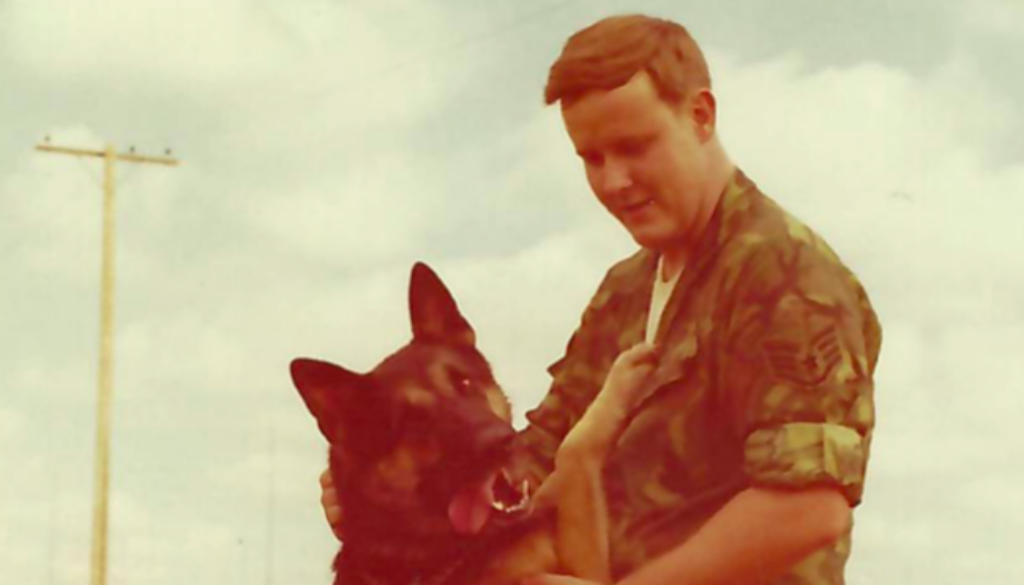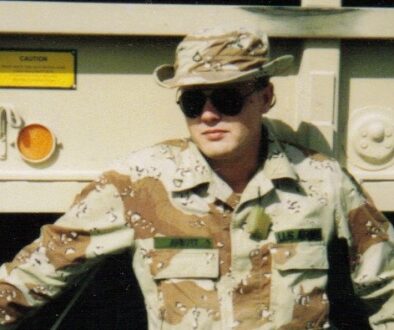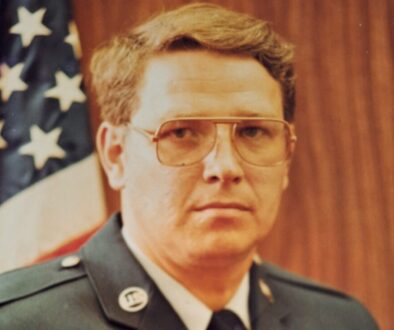Staff Sergeant Jim Belshaw, U.S. Air Force – Military Working Dog Handler in the Vietnam War
Serving in the U.S. Air Force changed the trajectory of Staff Sergeant Jim Belshaw’s life. He entered the military with a vague idea of what he was looking for but left eight years later with a firm purpose in mind. He saw every experience, from talking to fellow Airmen to guarding the perimeter of an air base in the Thai jungle during the Vietnam War, as an opportunity to learn and grow. This is his story.
Jim was born on the South Side of Chicago and remains a die-hard White Sox and Bears fan to this day. His father died four weeks after Jim’s eighth birthday and his mother remarried two-and-a-half years later. Jim’s new stepfather came from farming country in southern Illinois. He was not comfortable in Chicago, so he moved his new family about sixty-five miles southeast to the small town of La Porte, Indiana.
Although Jim’s stepfather was happy with the move, Jim was not. Having come from the hustle and bustle of Chicago’s South Side, he was not well-suited for small town life and didn’t like it. In fact, he couldn’t wait to leave and saw the Air Force as his ticket out. He graduated from La Porte High School in June of 1962 and shortly thereafter enlisted in the Air Force. His goal was to get into law enforcement, which at the time was known as the Air Police.
Jim reported for boot camp at Lackland Air Force Base in San Antonio, Texas. The July heat was so intense, he wondered what he was thinking when he decided to enlist in the summer. Despite the heat, he did well and managed to avoid the ire of his drill instructor, although on one occasion, he came close. Sometime around week six of the eight-week Basic Training, the drill instructor burst into the barracks for a surprise footlocker inspection. As the trainees popped to attention at the end of their bunks, the drill instructor made a beeline for Jim, got into his face, and said “Open your locker, Fox.” Jim replied, “Yes drill instructor, but I’m not Fox.” Fox was another trainee in the flight who looked like Jim. “What did you say?” the drill instructor barked. Jim repeated, “Yes, drill instructor, but I’m not Fox.” Someone on the other side of the room said, “That’s not Fox. He’s over here.” Not skipping a beat, the drill instructor left Jim and went over to the real Fox and dumped his footlocker on the floor. While feeling bad for Fox, Jim was thrilled he’d escaped the drill instructor’s wrath. He was even more thrilled that six weeks into Basic Training, the drill instructor didn’t know who he was, which meant he must be doing okay.
After Basic Training, Jim started in Air Police School, which was also at Lackland Air Force Base. It was there he learned that only about 10% of the Airmen in his class would actually get law enforcement jobs after completing the training, while the other 90% would work in base security, which meant protecting Air Force bases and facilities around the world and keeping the aircraft and people on the base safe. Jim was part of the 90%, and after graduating from Air Police School in December 1962, he reported to an air base in the United Kingdom (UK) known as Royal Air Force (RAF) Woodbridge which, together with nearby RAF Bentwaters, was home to the U.S. Air Force’s 81st Tactical Fighter Wing. Jim was assigned to the 81st Air Police Squadron, which provided security for the U.S. jet fighters and weapons stored at the base.
Jim found his duties incredibly boring until about eight or nine months into his tour. One night, he was standing guard at the gate leading to the flight line where four armed and ready fighters were parked when a fellow Airman on a roving K-9 (dog) patrol approached him. The Airman told Jim he was going home in three weeks and couldn’t wait. Then he asked Jim if he’d ever considered working with K-9s. Jim said “no” and the Airman replied he should. He added all the people who make your life hell will stop because they’re scared of the dogs. That was all Jim needed to hear. The next morning, he volunteered for K-9 duty.

Three weeks later, Jim’s unit sent him to the RAF Police Dog Training School at RAF Debden, located about fifty miles north of London. Not only did the Air Force send its Air Police dog handlers to be trained at the RAF school, but it also leased working dogs from the RAF because the UK had a strict six-month quarantine on dogs brought in from the United States. Upon reporting, Jim and a fellow Airman from New York City checked into the U.S. side of the student barracks. A little while later, they met some RAF Airmen heading to the UK side of the student barracks. Jim and his friend invited the RAF Airman to visit them but the UK students said they were forbidden from entering the U.S. side. Thirty minutes later, Jim and his friend had the UK students drinking beer with them and playing blackjack on the U.S. side.
Jim really enjoyed his time at the school and says tongue in cheek that it wasn’t long before all the RAF corporals or below loved him and everyone above the rank of corporal wanted him court-martialed. Because they were near U.S. facilities that had a base exchange, he could purchase cigarettes, beer, and whiskey cheaply and bring them back for parties at the school. He would make a run every Saturday, even taking orders to make sure he came back with what people wanted. The friendships and the fun made the two-month school pass by quickly.
Jim describes the sentry dogs they trained with as “bad dudes” and highly aggressive. The dogs had to be kept on a lead at all times because they were literally trained to attack anything that moved. It was not uncommon for a dog to turn on its handler, especially if the handler was trying to get the dog to release someone playing the bad guy in a leather padded attack suit. All handlers had scars on their hands from where the dogs had left their mark.
One other aspect of the training that stood out for Jim was that all of the upkeep, feeding, grooming, cleaning, and care for the dogs was assigned to young enlisted women from the Women’s Royal Air Force (WRAF) whose official job title was Kennel Maid. Despite having to deal with the aggressive dogs in much the same way as their male counterparts, military women were not permitted to be dog handlers in the UK until 1989. The U.S. Air Force opened the dog handler field to women in the mid-1970s, and Jim was glad to see the barriers to women lifted in both cases.
After completing his tour at RAF Woodbridge in December 1965, Jim was discharged from the Air Force and went back to live with his family in La Porte, Indiana. Just as he didn’t like it when he was a teenager, he continued not to like it now. His aversion for the area was exacerbated by having been on his own for almost four years, including having lived in the UK. Bored in La Porte and missing his time in the Air Force, he reenlisted in the fall of 1966 for four more years.
Now a Senior Airman, Jim was sent to the 687th Aircraft Control and Warning Squadron. The unit, which trained new second lieutenants to be air controllers for follow-on duty in Vietnam, was located on the high desert approximately ten miles west of Albuquerque, New Mexico, at a secluded radar site called West Mesa Air Force Station.
Jim was the only security person on the installation, which was fine because nothing bad ever happened. He described it as the closest thing to the TV show MASH he experienced during his time in the Air Force. He says if the Air Force had given him the opportunity to stay there for ten years, he would have accepted. There were only about one-hundred persons working at the facility, ten officers and ninety enlisted. Because the location was remote, military protocol was loose and the installation commander and the First Sergeant often left at 12:30 to play golf. Even better, the food was superb. So good, in fact, that generals and colonels from Kirkland Air Force Base in southeast Albuquerque would come to experience steak night on Tuesdays, Mexican food night on Thursdays, and lobster night on Fridays.
Beyond the amenities, Jim’s assignment at West Mesa was life-changing. While there, he met three enlisted Airmen, all with Masters Degrees, having enlisted in the Air Force for four years after graduate school to avoid being drafted into the Army or the Marine Corps. When one of them read a report Jim had written, he asked where Jim had gone to college. When Jim said he’d not gone to college, his new friends could not believe it. They insisted he enroll in an English 101 night course at the University of Albuquerque, which he did. Jim surprised himself by doing well. So well, in fact, that it gave him the confidence to take another course as soon as the next semester started. He excelled again and at that point he decided that once he was discharged, he would pursue his college degree, something he did not have the confidence to do before his three friends encouraged him. The seeds of his future were sown.
West Mesa Air Force Station closed in 1968 and Jim was one of the last persons to leave. He transferred to Oxnard Air Force Base in Southern California, where for the second tour in a row he worked in security without dogs. His initial responsibilities involved driving a pickup truck around the base to make sure the security details were properly posted at the start of each shift. His job changed for the better one night when the shift Technical Sergeant asked if there was anyone who knew how to type. Jim raised his hand and was immediately assigned as the desk sergeant working in the Security Operations nerve center because he could type the police reports and the daily crime blotter. The assignment proved to be a great opportunity and he was grateful his high school typing teacher, Ruthie Huddleston, had made him learn how to type.
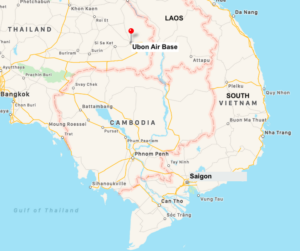
In 1969, Jim received orders to report to the U.S. Air Base in Da Nang in the Republic of South Vietnam. During his pre-deployment physical, the doctors discovered torn cartilage in one of Jim’s knees, probably the result of his dog training. He underwent corrective surgery, but when he fully recovered, he was sent to the 8th Security Police Squadron at Ubon Air Base in Thailand, rather than to Da Nang as originally planned.
The Air Force used Ubon Air Base to support special missions against the North Vietnamese. One major focus of the aircraft based there was to disrupt the flow of men, weapons, equipment, and supplies down the Ho Chi Minh Trail in southern North Vietnam and in Laos. The nighttime interdiction missions, referred to as Blind Bat missions, consisted of an unarmed C-130 dropping flairs on an area of suspected enemy activity, followed by a heavily armed C-130 gunship peppering the area with fire, while F-4 fighters flew cover overhead. Because the missions were taking a heavy toll, the North Vietnamese tried to infiltrate Ubon Air Base on three occasions using sappers to sneak through base defenses in order to destroy the U.S. aircraft there.
Jim arrived at Ubon Air Base in September of 1969, just a couple of months after the first sapper attack. That attack, which occurred on July 28, 1969, resulted in a K-9 handler and his dog both being wounded as they engaged the sappers escaping from the base after damaging several aircraft. Jim was there for the second attack, which occurred at approximately 2:00 a.m. on January 13, 1970. K-9 sentries played a key role in repelling the attack, which lasted about twenty-five minutes. In the end, one K-9 handler and his dog were wounded, and another dog, King, was killed after repeatedly attacking a sapper closing in on a C-130 gunship. All the sappers were killed. The third and final sapper attack occurred in 1972, long after Jim had returned to the United States.
The sapper attacks proved Jim and the other sentries had to be vigilant at all times and that they were engaged in deadly serious business. By this time, Jim was now a Staff Sergeant in charge of one of the two flights (shifts) of K-9 sentries. At the start of Jim’s twelve-hour shift, which began at 6:00 p.m., Jim would load all the sentries and their dogs into the back of a truck and then drop them off, one at a time, at their posts for the evening. He would also resolve any issues that came up with his team, like men or dogs getting sick or injured, and make sure all the sentry posts were covered.
With six months left of Jim’s one-year tour at Ubon, the non-commissioned officer (NCO) in charge of training informed him he needed to complete certain training. Jim told him he would be getting out of the Air Force as soon as he returned to the States, so there was no need to waste the training on him. The NCO agreed and Jim thought that was the end of it. After his night shift the next morning at 10:00, Jim was awakened by his Master Sergeant yelling, “So you don’t want to progress.” Jim asked the Master Sergeant what he was referring to. The Master Sergeant replied, “Well, the Air Force don’t want NCOs who don’t want to progress. From now on, you get a dog and you’re on the perimeter.”
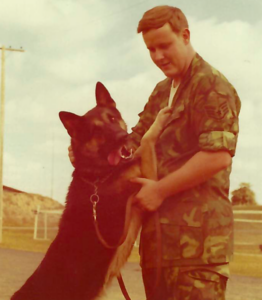
Now Jim knew what the Master Sergeant was talking about. When he told the training NCO the day before they didn’t need to waste the training on him because he was getting out, it meant he would not be eligible for promotion. Accordingly, the Master Sergeant took his leadership position away and reverted him to standing sentry duty. This lasted for six weeks, until the Master Sergeant had an apparent heart attack and was medically evacuated from Ubon. Jim was given his flight of K-9 sentries back, which he continued to lead until he departed Thailand.
Jim’s plan was to depart Ubon at the end of August 1970 so he could enroll at the University of New Mexico for the fall semester. This meant he had to leave before his scheduled departure date of September 2, which required special permission from a very stern and non-compromising Lieutenant Colonel. When Jim asked her if he could depart, she denied his request. He told what had happened to a young F-4 fighter pilot doing a rotation through the unit and, somehow, the junior officer got Jim orders to depart on August 30, which he did. Less than sixty hours later, Jim was in Albuquerque enrolled at the University of New Mexico, majoring in journalism.
Jim graduated from the University of New Mexico in December 1973 and took a job with the Las Cruces Sun-News. A year later, he jumped to the Albuquerque Journal, where he stayed until the University of New Mexico offered him a position in its Public Affairs Office in August 1975. He worked there for two years until he again heard the siren call of the Albuquerque Journal. He took a position as an Assistant City Editor and also became the Feature Editor when that position became vacant six months later. He is best known for the popular columns he wrote three to four times each week probing deep into the human experience hidden below most headlines. His columns appeared until he retired in 2009.
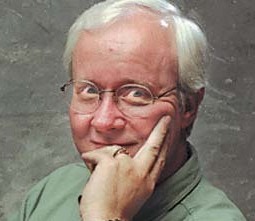
Jim also wrote freelance stories for the Vietnam Veterans of America (VVA) Magazine and covered two historic visits by Vietnam veterans to Vietnam in 1994 and 1995. These visits were instrumental in thawing and normalizing relations between the United States and Vietnam, which just twenty-one years before had been mortal enemies on the battlefield. Jim would go on to write numerous pieces for the VVA Magazine over the next twenty years on a wide range of topics, including Agent Orange, member profiles, and teaching about the Vietnam War.
Over the years, Jim received many accolades for his journalism. His awards include the Distinguished Graduate Award from the University of New Mexico, the ACLU First Amendment Award, the Anti-Defamation League Journalism Award, several New Mexico Press Association Awards, and the Albuquerque People’s Choice Award. He also authored three non-fiction Books: two collections of his columns and one about a dying young doctor and how his experience as a patient changed his views on the practice of medicine.
Now retired and living with his wife near Albuquerque in Corrales, New Mexico, Jim continues to be passionate about veterans’ issues and is a card-carrying member of the Vietnam Dog Handler Association. In fact, he and his wife share their house with a German Shepherd and an Australian cattle dog.
Voices to Veterans is proud to salute Staff Sergeant Jim Belshaw for his eight years of dedicated service to the Air Force, including his service at Ubon Air Base in Thailand during the Vietnam War. He went on to have a long and distinguished career in journalism, always finding the time to cover veterans’ issues like the groundbreaking visits by Vietnam War veterans to Vietnam as the two countries sought to move on from the war. We are grateful for Jim’s lifetime of service and wish him fair winds and following seas.
If you enjoyed Jim’s story, please sign up for the Voices to Veterans Spotlight monthly newsletter by clicking here. Once each month, you’ll receive a new written veteran’s story and a new podcast directly in your mailbox. Best of all, it’s free and you can unsubscribe at any time.


